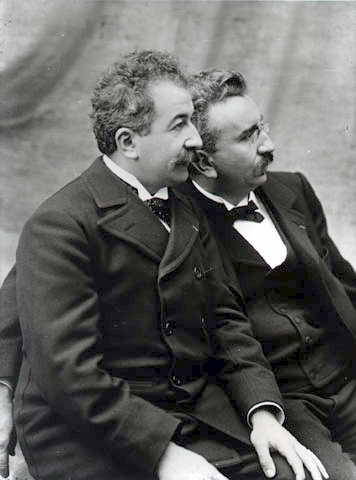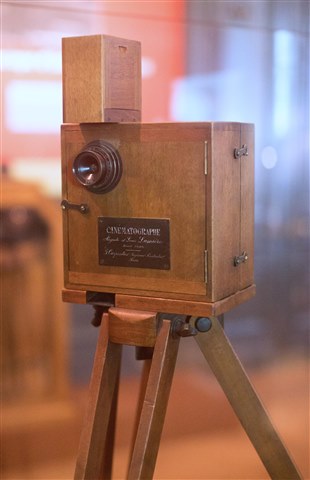On this day in (engineering) history…
The Lumiere Brothers film workers leaving the Lumiere Factory, 19 March, 1895
It is spring, 1895 (March 19, to be exact) in the French city of Lyon. After the end of their shift, workers at the Lumière factory are pouring out into the streets. Some have noticed a man standing behind a large, odd-looking wooden box on a tripod, who appears to be turning a handle on the side of the container. What the workers are seeing is themselves being filmed by one of their bosses, the Lumière Brothers (it is not recorded which), who own the photographic factory the staff are leaving.
The Brothers

Auguste (on the left) and Louis Lumière. Wikimedia Commons
Louis and Auguste Lumière grew up in Lyon, in the east of France, although they were both born in Besançon (Louis in 1862 and Auguste in 1864), sons of Charles-Antoine Lumiere, a painter and photographer. Antoine had moved to the town in 1861, where he opened a small photographic studio. After the family moved to Lyon, the boys attended the city’s largest technical school, La Martiniere.
In their youth, they both took to still photography. Louis spent time working to find a commercially viable method of developing film. He found a way of producing photographic plates, which worked well enough for him to open a factory, with financial help from Antoine.
Again, it was Antoine who sparked the brothers’ interest in moving film, after he had seen a demonstration of Edison’s Kinetoscope in Paris. Antoine had spotted the problem with the device’s ‘peepshow’ viewing method, and suggested his sons find a way of projecting film onto a screen.
Who invented Cinema? Depends where you live
In truth, what Louis and Auguste Lumière achieved was not unique, nor was it groundbreaking. Thomas Edison already had a somewhat bulky proto-film projector, the ‘Kinetoscope,’ where the image was viewed through a peephole at the top of the device.
In early 1890s London, William Friese-Greene and a civil engineer had designed a film camera, that was being built with the help of some mechanics. But like many other pioneers, they were unable to crack the problem of how to display the footage they could produce. At this time, a young electrical engineer teamed up with a renowned photographer called Birt Acres. Robert Paul, who had been manufacturing pirated Kinetoscopes and now needed product to put in them, teamed up with a renowned photographic expert, Birt Acres. They rapidly built a working camera and in the same month the Lumières filmed their workers, Acres and Paul filmed the University Boat Race of 1895. Their projected films would be the first screened in the UK, Spain, Portugal, South Africa, Australia and Denmark.

The Lumieres' Camera, the Cinématographe. Wikimedia Commons
Perhaps the most interesting developments were in New York, involving an early technological ‘what-might-have-been.’ The Lambda Company were seeing the bigger picture, literally. They had a system that shot 51 mm footage at 25 frames per second (the Lumières could only manage 16) in a wide 1.85:1 format.
In May 1895, Lambda’s first show took place on Broadway, New York City, where the company showed a 12-minute boxing fight, in a continuous loop. It used the Eidoloscope, the very first projector system, to show the film to the first paying audience to sit in front of a movie screen.
Why the Lumières triumphed
In spite of all these developments, it was the Lumières that won-out. They have been credited with showing the first projected film to a paying audience, thus inventing cinema. While this may not be quite right, their technology was a cut above the rest. Their ‘Cinematographe,’ (likely inspired from a design by Georges Demenÿ, who patented a moving picture camera in 1892), could shoot, develop and project the film.
Whilst Edison’s Kinetoscope was too cumbersome and individualistic to survive as a practical technology and business, the Lumières’ Cinématographe was clearly the way forward. The Eidoloscope didn’t last because the Lambda company was unable to find the contacts, organisation or financial power of either Edison or the Lumières. Paul & Acres and another pair of pioneers, the Skladanowsky brothers from Germany, were just pipped to the post by the Cinematographe.
The first Lumiere movies to be shown publicly simply showed a train pulling into a station and ‘Workers leaving the Lumiere factory’. Legend has it that when the audience at the Café de la Paix saw a locomotive heading straight for them, they fled in panic. Whether that is true or not, it’s a good demonstration of the power of the moving image.
The brothers didn’t take their invention seriously, they believed it to be simply a novelty and had withdrawn from the nascent film business by 1905. Their true passion was advancing colour photography, so they developed Lumiere Autochrome, the first practical colour photography process.
As for the movies, both brothers lived to see movies truly take off as the supreme 20th Century art form, moving from shorts of people going about their business to tales of murder, mystery, love, laughs and the occasional wonder.
What, if any, are your favourite engineers in movies? What are your favourite technological developments in film? Or, what technology seen in movies fascinates or inspires you? Leave your thoughts in the comments!
 By Stephen Phillips - IET Content Producer, with passions for history, engineering, tech and the sciences.
By Stephen Phillips - IET Content Producer, with passions for history, engineering, tech and the sciences.
